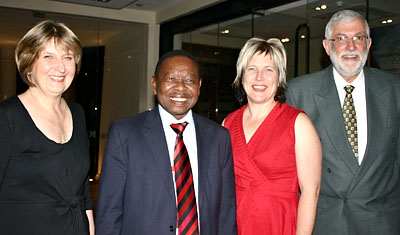 |
At the gala dinner were, from the left: Anlia Pretorius, Chairperson of HEDSA and Head of the Disability Unit at the University of the Witwatersrand; Dr Blade Nzimande, Minister of Higher Education and Training; Ms Hetsie Veitch, Head of the Unit for Students with Disabilities at the UFS; and Prof. Niel Viljoen, Vice-Rector: Operations at the UFS.
Photo: Leonie Bolleurs |
The first ever General Meeting of the Higher Education Disability Services Association (HEDSA) was held on the Main Campus of the University of the Free State (UFS) in Bloemfontein this week. HEDSA is a newly constituted body that represents the Disability Units from the various universities across the country.
The UFS is a member of HEDSA, which aims to work together to promote equal opportunities for students with disabilities in terms of access, participation and success in Higher Education.
The General Meeting forms part of the launching symposium with the theme: New Beginnings and New Directions. The symposium, attended by 15 higher education institutions in South Africa, served as a platform to explore innovative approaches to assist in improving services for students with disabilities.
Dr Blade Nzimande, Minister of Higher Education and Training, was one of the speakers at the gala dinner of this prestigious event. He said that there is still a lot of work to do to overcome discrimination against students as well as staff members with disabilities at higher education institutions. Minister Nzimande quoted from the Soudien report, a government-commissioned report that brought to light discrimination – especially racism and sexism – still endemic at South African universities. “Victims, in this instance referring to students and staff with disabilities, are denied the opportunity – either through a lack of access to opportunities or due to outright discrimination – to realise their full potential. In the process, the country is robbed of valuable but untapped human resources. Higher education institutions cause incalculable damage to South African society by failing to deal boldly with these issues. Where institutions have indeed taken action, the benefits to individuals, to the different social groups in the country, as well as to the institutions themselves, have been major.”
He stated that he believed that HEDSA as well as the symposium could play a vital role that would assist in this process.
Ms Hetsie Veitch, Head of the Unit for Students with Disabilities at the UFS, was elected as treasurer of this body for the following two years. Johnny Mokoka will represent the UFS in HEDSA’s National Student Organisation for Students with Disabilities that was established during the symposium this week.
Media Release
Issued by: Leonie Bolleurs
Strategic Communication
Tel: 051 401 2707
Sel: 0836455853
Email: bolleursl@ufs.ac.za
30 September 2010